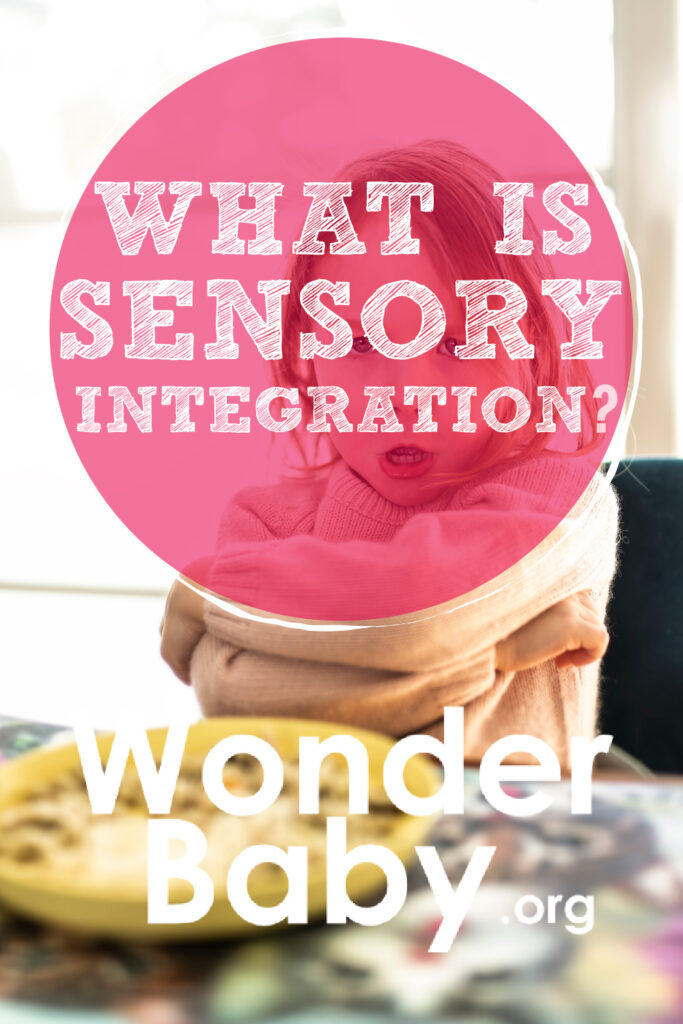What Is Sensory Integration?

- Processing sensory information is a complex cognitive function.
- Children with no sensory integration issues respond appropriately to sensory input.
- Sensory integration issues could lead to developmental and behavioral disorders.
- Sensory integration therapy, behavioral interventions, and other evidence-based practices can help children and young adults with a sensory processing disorder navigate life comfortably.
- Sensory integration disorder is a spectrum disorder.
I read a lot about child development in preparation for our first child. My mother often educates children with autism spectrum disorder, and I wanted enough knowledge to notice early signs and ask her for help if needed.
There are some big words and difficult-to-understand terms on the internet, with most articles written by professionals who use even bigger words and complicated definitions.
“What is sensory integration?” was one of my first searches. There are excellent studies answering this!
But as a mom, I know how crowded your brain probably feels. So, I’m breaking down everything you need to know into easy-to-understand sections.
The world around us bombards us with a constant stream of sensations. Most people have a sensory system that effortlessly processes these inputs and allows them to easily navigate everyday life.
But when this system doesn’t, sensory processing difficulties come into play. Understanding how this affects child development is crucial.
Sensory Integration: What You Need to Know

Sensory integration is the brain’s ability to receive, process, and organize information from the senses. This includes:
- Touch
- Sound
- Sight
- Taste
- Smell
- Movement
In short, it’s the brain’s way of making sense of the world around us.
Sensory integration is crucial for your child’s overall development. It lays the foundation for body movement, attention, social interaction, emotional regulation, and learning.
If your little one’s sensory integration functions smoothly, they’ll be better equipped to engage with everyday life.
Your child could experience sensory integration issues on one of four levels. These are:
- Under-responsivity: Your child could have a muted response to sensory stimuli. This means they might seem unaware of temperature changes or expected pain.
- Over-responsivity: Your child might be hypersensitive to certain sensations. This could lead to strong and sometimes negative reactions. Certain textures, bright lights, or sounds could trigger them.
- Sensory seeking: Your child could actively seek sensory experiences, like touching or smelling. They could also enjoy activities that provide deep pressure, swinging, or spinning.
- Sensory avoiding: Your child might try to avoid sensory experiences, like eating certain foods, physical touch, or busy environments.
How your child processes sensations directly affects their development. Sensory issues can lead to challenging behavior and learning disabilities.
How Does Sensory Integration Affect Child Development?

Our senses help us make sense of the world around us. For kids, this is like a superpower through every developmental phase.
When sensory integration works smoothly, kids can focus, learn, and behave better. It’s easier for them to socialize, play, and tackle challenges.
When your child’s brain struggles to make sense of all the sensory input, it affects their development.
This is how:
Sensory Integration Influences Motor Skills
Sensory input plays a monumental role in developing motor skills. Babies who learn to grasp, crawl, or walk get sensory feedback through their sense of touch and awareness.
Your little one will feel the materials of their toys, the ground beneath their feet, the texture of the floor on their hands and knees, and the finish of the table when they need help staying upright.
If your child is sensitive to specific materials, they could avoid practicing these skills.
Sensory Integration Influences Attention and Focus
Proper sensory integration helps children filter out distractions. If your little one is hypersensitive to noise or has tactile sensitivities, the buzzing of fluorescent light or the tag on their shirt could feel like a major disruption.
This can make it tough for your kid to focus on the activity they need to do, follow instructions, or listen.
Sensory Integration Influences Social Interactions
Sensory processing will affect how your child responds to touch and personal space. Your child might not like when others touch them and shy away from hugs or physical contact. This could make them uncomfortable in certain social situations.
If your little one seeks sensory stimuli, it could also affect how they engage with others. They could enjoy deep pressure or tight hugs. This can lead to unexpected reactions from those who don’t understand this behavior or feel uncomfortable.
Sensory Integration Influences Emotional Regulation
Children with sensory integration difficulties have a harder time regulating their emotions. When they become overwhelmed, they’re more likely to feel anxious, irritable, and have meltdowns.
While most kids fit this description, those with sensory processing deficits need additional tools to handle stressful things in their environment. You could teach your little one to turn to breathing exercises or sensory toys when they struggle to control their emotions.
Sensory Integration Influences Self-Confidence
Children who navigate their sensory world comfortably have more self-confidence. Feeling capable of handling different sensory challenges boosts self-esteem and allows kids to explore new activities and environments without fear.
When children have sensory integration issues, a bustling playground, noisy classroom, or new social setting can be overwhelming.
Signs That a Child May Have Sensory Integration Issues

Sensory challenges present differently from child to child. Some children are hypersensitive to sensory information, while others seek out sensory stimulation.
According to some studies, including the 2017 published study “Identification of Sensory Processing and Integration Symptom Clusters: A Preliminary Study”11. Miller, L. J., Schoen, S. A., Mulligan, S., & Sullivan, J.. Identification of Sensory Processing and Integration Symptom Clusters: A Preliminary Study. Occupational Therapy International. 2017;2017, 1–10. https://doi.org/10.1155/2017/2876080, it’s believed that between 5% and 16% of children have symptoms associated with sensory integration problems.
The signs of sensory integration issues can be divided into six categories. These are the most common:
Sensitivity to Sensory Input
Children with auditory sensitivity might find certain sounds too loud. Your little one could cover their ears or get fidgety when things get noisy.
If they have tactile sensitivity, your child might refuse to wear certain materials because they feel “scratchy” or have tags that keep bothering them.
Visual sensitivity can show as your kid squinting their eyes when exposed to bright lights. They could also get agitated when they see busy patterns or colorful spaces.
Kids with oral sensitivity issues are mostly picky eaters. The texture, taste, and even smell of certain foods could make them squirm.
Seeking Sensory Input
Some children have sensory-seeking behaviors. If this is your little one, you might notice them constantly moving, whether fidgeting, spinning, or rocking back and forth.
If your kid seeks intense sensations, they’ll likely become obsessed with tight hugs, hand squeezes, or tight-fitting clothes. They could also prefer heavy blankets that put extra weight on their bodies.
Some sensory-seeking children are fascinated with bright lights, busy patterns, or objects that glow or shine.
Others get this sensory input by putting objects in their mouth. Your child could nibble on toys, pencils, or even their clothes.
Avoiding Sensory Input
Children with sensory issues often avoid input altogether. These little ones may shy away from any type of physical contact, even from you! They’re also usually not fans of crowded places like shopping centers, and you’ll notice them playing alone at birthday parties.
If your little one is sensitive to a specific texture or smell, they’ll avoid all foods and drinks that fit this category. Similarly, you’ll notice that they only wear particular types of clothing.
Motor Skill Challenges
Sensory integration issues could also lead to motor skill hurdles. Your little one might struggle with balancing or have trouble coordinating their moves. They could end up avoiding physical activities altogether.
Motor skill challenges could also lead to poor handwriting or no interest in play or exploration.
Social Interaction Challenges
Kids dealing with sensory processing difficulties can find it difficult to make friends. They could have trouble connecting with other kids their age because of their sensory needs.
Other children might prefer their own company if social interactions lead to sensory overload.
Emotional and Behavioral Challenges
Sensory processing difficulties can manifest as behavioral disorders. Your little one could have intense emotional outbursts over things that seem small to the rest of us.
Their sensory triggers could also lead to meltdowns and tantrums.
If your child struggles to switch from one activity or environment to another, they may have difficulty processing transitions.
Some children might also refuse to do activities that involve specific sensory experiences, like swimming, finger painting, or jumping on a trampoline.
Note: All children can experience sensory difficulties to varying degrees. Sensory processing issues exist on a spectrum. It’s important to know the signs and recognize when they persist.
This can be the first step in providing your child with the support and understanding they need.
Can a Child Have Sensory Integration Issues and Not Be Autistic?

Sensory integration issues are not exclusive to autism spectrum disorder (ASD) and can affect children of all neurodiversity.
Genetics, developmental factors, and environmental influences cause sensory integration issues. Your little one can experience sensory issues without any other diagnosed condition.
How to Help a Child Overcome Sensory Integration Problems

Children with sensory integration difficulties need tailored strategies for their specific challenges. Understanding their unique sensory needs is the first step.
You should consult an occupational therapist specializing in sensory processing disorders for a professional evaluation if your little one has persistent sensory problems. They can assess your child’s sensory profile, identify specific challenges, and develop a personalized treatment plan.
These treatment plans typically include:
- Clear, measurable goals related to improving your child’s ability to process sensory information. Your occupational therapist will monitor your child’s response throughout treatment and adjust these accordingly.
- Personalized activities and strategies that provide your little one with the right type and amount of sensory information to help them self-regulate.
- Therapeutic interventions like sensory integration therapy, desensitization, and sensory-based occupational therapy.
The intensity and duration of your child’s treatment plan depends on their age, developmental stage, and the specific challenges they face.
You could self-diagnose and treat mild sensory difficulties with home-based activities. However, a treatment plan is necessary if your little one has persistent sensory integration issues and behavioral concerns.
How to Overcome Sensory Integration Problems At Home

If you want to treat your child’s sensory processing issues at home, you’ll need to create a sensory-friendly environment and incorporate sensory activities and strategies into their daily routine.
Here are some ways you can support your child’s challenges at home:
Create a Sensory-Friendly Environment
Start by identifying your child’s sensory needs and triggers. Ensure their environment includes activities that provide their desired input or reduce triggers.
If your little one is sensory seeking, include deep-pressure activities using a weighted vest or blanket. Blackout curtains or noise-canceling headphones could reduce triggers if your child is sensitive to these inputs.
You should also organize and simplify your house to reduce sensory overload. Providing sensory breaks by using a calming sensory corner with sensory tools like weighted blankets, fidget toys, and calming music can also help.
Create a Sensory Treatment Plan
Most children thrive on routine. Those with sensory difficulties are no different! You should establish a daily routine that incorporates activities to help your child self-regulate or reduce sensitivity. Occupational therapists refer to this as a “sensory diet.”
This routine should accommodate your child’s specific sensitivities and sensory-seeking behaviors.
A sensory bin, jumping on a trampoline, and playing in the sand can all be great activities.
Gradual exposure to stimuli your child finds challenging is also crucial if your goal is to reduce sensitivity over time.
Create an Open Dialogue and Educate Yourself
You should encourage your little one to express their feelings and sensory needs. Be understanding and supportive. This will help them develop body awareness and self-regulation.
If your child is in school, be open with educators about their needs and your treatment plan. Ensure that everyone understands how to help your child when they experience sensory difficulties. You’ll find that many educators can also input ideas.
Continued education about sensory processing issues will help you understand your child’s challenges better. Talk to experts, read books and articles, and join support groups.
From Chaos to Calm!

Understanding your child’s sensory processing issues will help you help them find balance in this sometimes overwhelming world.
Consistency and patience are key when addressing these issues at home. You should also create sensory-friendly spaces, establish routines, and provide unwavering support to help your little one navigate their sensory journey.
Identifying and understanding your child’s sensory needs and finding the most effective strategies may take time, so be open to trying different approaches and adjustments.
Remember to consult with professionals for guidance and seek support. With the right knowledge and tools, your little one’s chaotic world will turn into calm, one step at a time.
References
- Miller, L. J., Schoen, S. A., Mulligan, S., & Sullivan, J. (2017). Identification of Sensory Processing and Integration Symptom Clusters: A Preliminary Study. Occupational Therapy International, 2017, 1–10. https://doi.org/10.1155/2017/2876080

Related Posts

Eye Conditions and Syndromes, Visual Impairment
Neuralink Announces Plans to Restore Sight to the Blind with Brain Chip
Elon Musk’s company Neuralink has announced plans to begin human trials of its new “Blindsight” brain chip by the end of 2025.

Special Needs
5 Spring Cleaning Tips for Families of Children with Disabilities
Spring cleaning is an opportunity to create a more accessible, organized, and supportive space for your child with disabilities. Declutter, deep clean, and refresh!

Visual Impairment
The Gift of Understanding: How a Young Child Helps His Blind Father Navigate Life
When a parent is blind, it’s natural for people to wonder how their sighted child will adapt. Will they struggle to understand their parent’s needs? Will they feel burdened by...